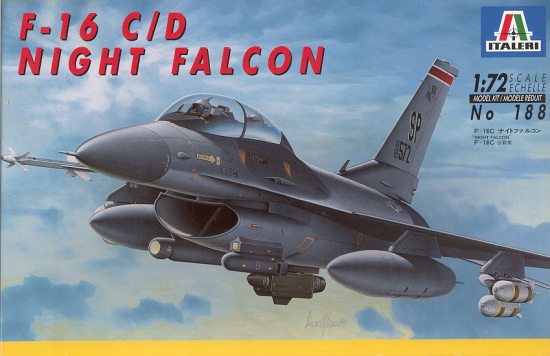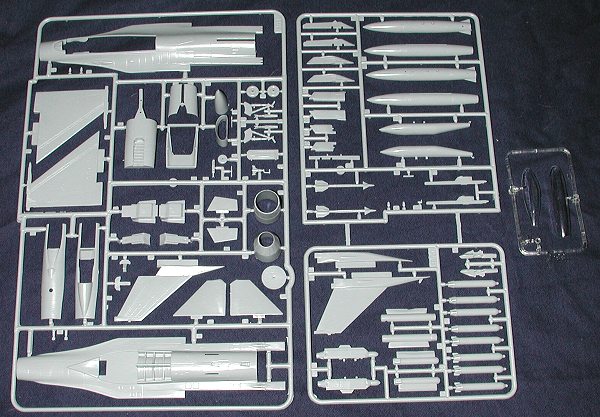
|
KIT: |
Italeri 1/72 F-16C/D 'Night Falcon' |
|
KIT # |
188 |
|
PRICE: |
$9.95 |
|
DECALS: |
Two aircraft |
|
REVIEWER: |
|
|
NOTES: |

|
HISTORY |
The most successful US tactical jet of the last 25 years? Yes, I do think that one could easily say that. Not only has it been exported more than any type in that time, but it is still in production since the first flight in 1974/5. Though the plane looks very much the same, there have been a huge number of improvements in engine and avionics, not to mention some airframe changes that will allow the initiated to be able to tell the difference between them. I must confess to you all that I pay little attention to modern aircraft as I once did so a large mental database on these planes has gone away from lack of use!
I can tell you that they have proved themselves to be good light bombers and adequate dog-fighters. I find it interesting that the only US F-16 to shoot down an enemy plane in recent years (perhaps ever) was a two seater! Again, I know little of the air to air combat history of US F-16s so perhaps a more enlightened reader can fill in the details I missed. However, I do know that the major mission of the F-16 is moving mud and not air interception. Now before I get e-mails from a number of ANG guys who are flying the air defense mission, I do realize that in the US, that is one of their major roles in the Guard. However, in the regular USAF, most of them are ground attack.
That is why in the Night Falcon, there are the FLIR and other sensors to allow pilots to be precise in delivering free-fall munitions. The systems used are similar if not the same as used in the F-15E Strike Eagle. This allows for accuracy in all weather and lighting conditions. Thanks to constant upgrades of the airframe, and the relatively low cost of the aircraft, there will be F-16s around for many more decades.
|
THE KIT |

Well, if you have seen one F-16 kit, then you have seen them all. At least one thing about the Falcon is that there really seems to be only one way to mold them, so if you have built a number of different kits, whether they be Monogram, Tamiya, Hasegawa, ESCI, Revell......, they all are basically the same in layout and design. The difference is in the details. What you have here is your basic F-16A/B kit with an extra sprue that is supposed to make it an F-16C/D. That sprue is in the lower right of the above image and includes the new F-16C/D tail, the 'Night Falcon' chin sensors and a load of Rockeyes and an ECM pod.
All the rest of the stuff for the earlier versions is still there. Good thing, too as some of the markings are for those earlier versions. One this that is not included are the smaller horizontal stabs to do a very early US F-16A/B. Actually, those smaller stabs are not that easy to find. Just trimming the kit ones isn't the solution as the older ones were a bit longer! The cockpit is basic but acceptable. I'm sure that most of you who want to spruce things up will have no trouble finding resin or brass bits to fix it up. Options are, of course, the ability to do a single seat or twin seat plane. You'll have to be satisfied with having the canopy closed as part of the framework is molded into the upper fuselage inserts. Other options are a fully open or fully closed afterburner nozzle and a number of under wing stores. You also have the ability to do the longer lower fin housing for some of the European F-16s. This kit only makes the 'small mouth' F-16C/D, another kit being made to offer the larger intake.
As to the general molding of the kit, it is fair. There are sink marks on several of the thicker parts, like the wing roots and the TER's. Ejector pin marks and flash are not a problem at all. The interior is minimalist with instrument represented by decals. Wheels are a bit toy-like so should be replaced. I don't think anyone does resin replacement wheels for a 1/72 F-16 so you may be stuck with what's in the box. Attachment points for the wing racks are engraved so there is no real positive locator for them. This is undoubtedly due to the single piece wings. There are also engravings for three racks, though only two are supplied so you'll have to use filler on what's not needed.
 Instructions are typical of
Italeri, which is to say they are very good. Good color and parts placement in
addition to a thoughtful construction sequence. Since you can build this as any
major F-16 subtype, you need to pay attention to the instructions so you won't
miss something. Four different aircraft are presented on the decal sheet. First
is a Dutch F-16B from 315 Squadron followed by a Belgian F-16A from 1 Squadron.
All of these planes are shown in the three greys scheme of FS 36375, 36321, and
36118 with 36320 radomes. Frankly, I'd be willing to bet that the box art plane
is in the newer two grey scheme, though I don't remember which grey was
eliminated! The other two planes are a 496 TFS F-16C from Hahn AB in 1988 and is
shown on the back of the box. The final scheme is for an F-16D and this is the
only 'Night Falcon' scheme on the sheet. It is a 52 FW aircraft from Spangdahlem
AB in Germany. There is no decal placement guide for this plane, only the box
art. As you can see, all the markings are Euro-centric. The Night Attack F-16s
in the US were mainly concentrated with the 388th FW at Hill AFB in Utah, though
I understand that the 20th FW at Cannon now has them as well. For those
that don't like the kit decals, there are LOTS of aftermarket options.
Instructions are typical of
Italeri, which is to say they are very good. Good color and parts placement in
addition to a thoughtful construction sequence. Since you can build this as any
major F-16 subtype, you need to pay attention to the instructions so you won't
miss something. Four different aircraft are presented on the decal sheet. First
is a Dutch F-16B from 315 Squadron followed by a Belgian F-16A from 1 Squadron.
All of these planes are shown in the three greys scheme of FS 36375, 36321, and
36118 with 36320 radomes. Frankly, I'd be willing to bet that the box art plane
is in the newer two grey scheme, though I don't remember which grey was
eliminated! The other two planes are a 496 TFS F-16C from Hahn AB in 1988 and is
shown on the back of the box. The final scheme is for an F-16D and this is the
only 'Night Falcon' scheme on the sheet. It is a 52 FW aircraft from Spangdahlem
AB in Germany. There is no decal placement guide for this plane, only the box
art. As you can see, all the markings are Euro-centric. The Night Attack F-16s
in the US were mainly concentrated with the 388th FW at Hill AFB in Utah, though
I understand that the 20th FW at Cannon now has them as well. For those
that don't like the kit decals, there are LOTS of aftermarket options.
|
CONCLUSIONS |
This is about as eclectic a kit as you can find. Allegedly, you can do any F-16 version from this kit, though I'm sure that there are detail differences that have been missed. Bulged main gear doors or something. It needs help in the cockpit and wheel department as well as some decent TERs. However, for the price, it is a very reasonable kit and undoubtedly gets built quite a lot!
If you would like your product reviewed fairly and fairly quickly by a site that has well over 150,000 visitors a month, please contact me or see other details in the Note to Contributors.